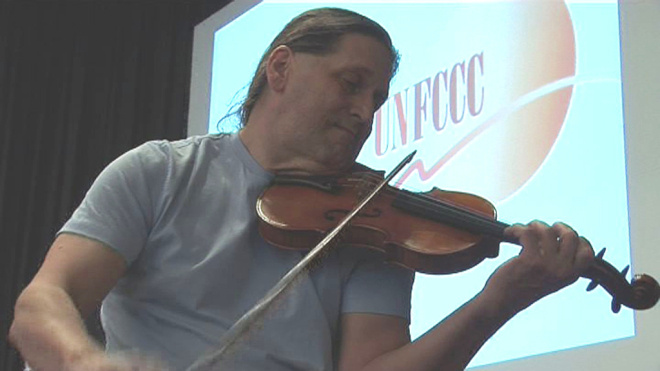Hello ladies and gents this is the Viking telling you that today we are talking about
Mohammed Valli Moosa

Civil servant
Mohammed Valli Moosa, 50, was South Africa's environment minister from 1999 to 2004. He has campaigned for transnational African "Peace Parks" for wildlife and pushed for reduced use of plastic bags. But he may play a much greater role in the global environment debate as chairman of Eskom, the state-owned power company that runs South Africa's only nuclear plant and, starting in 2008, is hoping to build dozens of fourth-generation small-scale nuclear stations. Known as pebble bed modular reactors, these are smaller, cheaper and reportedly safer than other designs and Valli Moosa says they could be the base of the 21st eco-economy - ideally for desalination plants and creating the raw material for the heralded but slow to appear hydrogen economy. South Africa has some of the world's greatest reserves of uranium: put them with the technology and it could start looking like a superpower.
Aubrey Meyer

Musician and activist
Can a 60-year-old South African violinist living in a flat in Willesden, north London, actually change the world? It's a serious question because the odds are increasing that over the next two years rich and poor countries will come round to Aubrey Meyer's way of thinking if they are to negotiate a half-decent global deal to reduce climate change emissions.
Nearly 20 years ago, Meyer devised what he believed was the only logical way through the political morass dividing rich and poor countries on climate change. After a letter from him was published in the Guardian, he gave up playing professional music to set up the tiny Global Commons Institute in his bedroom. There he developed the idea that not only did everyone on earth have an equal right to emit CO2, but that all countries should agree to an annual per capita ration or quota of greenhouse gases.
That was the easy bit. But then the musician, who had played with the LPO and had written for the Royal Ballet, went further. Meyer proposed that each country move progressively to the same allocation per inhabitant by an agreed date.
This meant that rich countries would have steadily to cut back their emissions, while poor ones would be allowed steadily to grow theirs, with everyone eventually meeting in the middle at a point where science said the global maximum level of emissions should be set. He called it "contraction and convergence" (C&C).
Meyer is nothing if not determined. Since 1990, earning next to nothing and sometimes practically begging for money so he could lobby international meetings, he has pressed C&C at every level of global government. Early opposition came from British civil servants, who said it was akin to communism, and major environmental groups, which were ideologically opposed to any kind of trading emissions. For many years the US government had no interest in any such deal.
But the climate stakes have risen with every new scientific report, and the politicians and environment groups have moved on. As the urgency for a global agreement has grown, so C&C has emerged as one of the favourites to break the international impasse.
"Its advantage is that it is far simpler and fairer than the Kyoto agreement, which applied only to a few rich countries," Meyer says.
It also allows science to set the optimum level of emissions; it gets round long-standing US objections that poor countries should be part of a global agreement; and it is inherently pro-business, because it encourages rich and poor countries to trade emissions between themselves.
The long years of single-minded lobbying mean that Meyer's idea now has some powerful backers, including, in Britain, the Royal Commission on Environmental Pollution; 180 MPs have supported it in an early day motion, and the government, equivocal so far, is moving towards a version of it. It has become official policy in India, China and most African countries. Germany and India are expected to run with it in UN meetings. Angela Merkel, the German chancellor, has backed C&C publicly.
Other proposals are emerging and it will take two more years to thrash out a system that will please everyone. But few have the elegance of C&C. "It's the least unfair of all the proposals that have been put forward," Meyer says. "It secures survival by correcting both fatal poverty and fatal climate change in the same arrangement."
Writing music and calculating emissions have a lot in common, he says. "Look at a sheet of music and you would not know what it was. But when you hear it played, then it's beautiful. Equally, when you read the calculations on countries' gases, they mean nothing. But when you work out how you can reduce them, it's clear that it's the best thing for humanity."
Monica Howe

Bike activist
Monica Howe, 31, is the sharp end of the grassroots debate in Los Angeles, the global car culture's smog- choked, road-raged, increasingly grid locked spiritual home. Her Bicycling Coalition group is remapping the megalopolis's mean and potholed streets by forging bike routes, organising cycle rallies, helping fledgling cyclists overcome traffic fears, and challenging the mindset at City Hall, where cyclists tend to be greeted with disbelief. Howe says membership is rising, and cyclists are pedalling into the cityscape as public attitudes, swayed by concerns about air quality, traffic congestion and global warming, begin to shift. She's no Al Gore, but she is winning the battle for American hearts and minds, despite the overwhelming odds.
Comments
Post a Comment